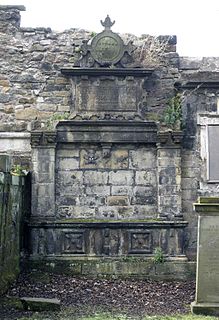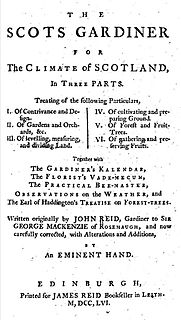Related Research Articles

Penicuik is a town and former burgh in Midlothian, Scotland, lying on the west bank of the River North Esk. It lies on the A701 midway between Edinburgh and Peebles, east of the Pentland Hills.

Alexander Monroprimus was a Scottish surgeon and anatomist. His father, the surgeon John Monro, had been a prime mover in the foundation of the Edinburgh Medical School and had arranged Alexander's education in the hope that his son might become the first Professor of Anatomy in the new university medical school. After medical studies in Edinburgh, London, Paris and Leiden, Alexander Monro returned to Edinburgh, and pursued a career as a surgeon and anatomy teacher. With the support of his father and the patronage of the Edinburgh Lord Provost George Drummond, Alexander Monro was appointed foundation Professor of Anatomy at the University of Edinburgh. His lectures, delivered in English, rather than the conventional Latin, proved popular with students and his qualities as a teacher contributed to the success and reputation of the Edinburgh medical school. He is known as Alexander Monro primus to distinguish him from his son Alexander Monro secundus and his grandson Alexander Monro tertius, who both followed him in the chair of anatomy. These three Monros between them held the Edinburgh University Chair of Anatomy for 126 years.

The Royal College of Surgeons of Edinburgh (RCSEd) is a professional organisation of surgeons. The College has seven active faculties, covering a broad spectrum of surgical, dental, and other medical practices. Its main campus is located on Nicolson Street, Edinburgh, within the Surgeons' Hall, designed by William Henry Playfair, and adjoining buildings. The main campus includes a skills laboratory, the Surgeons' Hall Museums, a medical and surgical library, and a hotel. A second office was opened in Birmingham (UK) in 2014 and an international office opened in Kuala Lumpur, Malaysia, in 2018.

Tweedie or Tweedy is a Scottish clan name. The Clan Tweedie does not currently have a chief recognized by the Lord Lyon King of Arms and is therefore considered an Armigerous clan. However the surname is also considered a sept of the Clan Fraser. The name is derived from the lands of Tweedie which were along the Valley of the River Tweed in Peebleshire in the Scottish Borders.

Clan Leslie is a Lowland Scottish clan.

John Monro of Bearcrofts (1670-1740) was a Scottish surgeon who was the progenitor of the Monro dynasty of anatomists in Edinburgh. He is credited with conceiving and playing a major role in founding the University of Edinburgh Medical School. He served as Deacon (President) of the Incorporation of Surgeons of Edinburgh.

John Lauder (1683–1737) was a Scottish surgeon, who was Deacon (President) of the Incorporation of Surgeons of Edinburgh for four separate terms of office. His portrait c.1700 by the artist William Aikman (painter) is on display at the Royal College of Surgeons of Edinburgh.

Gilbert Primrose was a Scottish surgeon who became Surgeon to King James VI of Scots and moved with the court to London as Serjeant-Surgeon to King James VI and I on the Union of the Crowns. He was Deacon of the Incorporation of Surgeons and Barbers of Edinburgh on three occasions.

Gardening in Scotland, the design of planned spaces set aside for the display, cultivation, and enjoyment of plants and other forms of nature in Scotland began in the Middle Ages.

Sir Henry Wade PRCSE FRSE DSO CMG was a Scottish military and urological surgeon. He was elected president of the Royal College of Surgeons of Edinburgh in 1935. His collection of anatomical specimens was donated to Surgeon's Hall in Edinburgh and is known as the Henry Wade Collection.

James Borthwick of Stow (1615-1675) was a Scottish surgeon who was the first teacher of anatomy in the Incorporation of Surgeons and Barbers of Edinburgh. He was Deacon (President) of the Incorporation on two occasions and a member of the Scottish Parliament. Borthwick was largely responsible for the formal creation of the surgeon-apothecary in Edinburgh.
John Naysmith was a Scottish surgeon who became surgeon to King James VI of Scotland and was appointed Royal Herbalist in London when the monarch became King James VI and I. He was Deacon (President) of the Incorporation of Surgeons and Barbers of Edinburgh.

Gideon Eliot (1664-1713) of North Sintoun in Roxburghshire was an Edinburgh surgeon. He served as surgeons to the 26th Regiment of Foot. He was elected Deacon (President) of the Incorporation of Surgeons of Edinburgh on two occasions.

William Borthwick of Pilmuir (1641-1689) was a Scottish surgeon who, having studied at Leiden and Padua, was the first to bring an international perspective to the Incorporation of Surgeons of Edinburgh. He served as Deacon (President) of the Incorporation from 1675-1677 and again from 1681-1683.
Alexander Monteith of Auldcathie (1660-1713) was an Edinburgh surgeon, who in his three terms as Deacon (President) of the Incorporation of Surgeons of Edinburgh, presided over some of the most important changes in its history. These included obtaining the rights to perform anatomical dissection on the bodies of prisoners dying in jail, the granting of a Royal Charter by William and Mary in 1695, and the construction of the original Surgeons' Hall, the first permanent home of the Edinburgh Surgeons.

Adam Drummond of Binend (1679-1758) was a Scottish surgeon-apothecary who was appointed, jointly, as the first Professor of Anatomy at the University of Edinburgh.
Scottish Russians are Russians with full Scottish ancestry. Scottish migration to Russia occurred primarily during the early-17th-century Polish–Muscovite War (1605–1618), Ingrian War (1610–1617) and Thirty Years' War (1618–1648). Some estimates of the number of Scottish settlers in Russia during the 17th century are as high as 100,000. This has led some demographers to believe that the current number of Scottish Russians could be up to 1-2 million. There are believed to be around 400 different Russian surnames that owe their names to Scottish ancestors.

Sir Thomas Livingstone, Viscount Teviot was an military officer of Scottish descent who was born in the Dutch Republic, and spent his career in the service of William of Orange.
Alexander Strachan was church of Scotland minister. He was exiled following the General Assembly of Aberdeen for not retreating from his presbyterian principles.
George Lauder, was an Edinburgh surgeon who was deacon (president) of the Incorporation of Surgeons of Edinburgh in 1744. During the Jacobite rising of 1745-46 he cared for the wounded after the Battle of Prestonpans, acted as surgeon with the Jacobite army on its march into England and retreat to Scotland, where he cared for wounded after the Battle of Falkirk.
References
- 1 2 3 4 Cresswell, CH. History of the Royal College of Surgeons of Edinburgh. Edinburgh, Blackwell, 1926. p27
- ↑ Historic Environment Scotland. "NEWHALL (GDL00297)".
- 1 2 Dingwall, H. A famous and Flourishing Society. Edinburgh, Edinburgh University Press, 2005. p63
- 1 2 Aitken, George Atherton (1895). . In Lee, Sidney (ed.). Dictionary of National Biography . 44. London: Smith, Elder & Co.